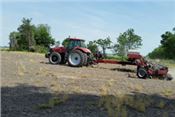Increasing Planting Capacity: Wider Versus Faster Planters

At UT’s upcoming Milan No-Till Field Day, farmers can learn how planter width, planting speed
and seed loading methods influence planting efficiency, i.e., how many acres you can
expect to plant in a day.
Photo courtesy UTIA
MILAN, TENN.
Farming is known to be a difficult business. Many producers can have excellent weather and few pest and weed problems and still find themselves straddling the line between profitability and losing money because of their planting decisions.
Mike Buschermohle, a biosystems engineering professor in the University of Tennessee Institute of Agriculture, says decisions regarding planting, including planting capacity, are among the most crucial decisions a farmer will make all year. At UT’s upcoming Milan No-Till Field Day, Buschermohle will discuss the results from a study that examined how planter width, planting speed and seed loading methods influence planting efficiency, or more importantly, how many acres you can expect to plant in a day.
First, Buschermohle says, it is imperative to understand planter performance. “Planting capacity is a function of the maximum capacity a planter can obtain while operating at 100 percent of its width for a given speed and planter efficiency at that speed.”
In a recent study, Buschermohle predicted field efficiency and capacity values across 41 fields using planters with different widths at planting speeds ranging from 4 to 12 mph. As expected, the study showed that increasing planting speed decreased planting efficiency and increased planting capacity across all planting speeds and planter widths. What was a little surprising was the extent of the differences.
“For example, planting efficiency for a 38-foot wide planter with individual row-unit seed hoppers decreased from 76.4 percent to 58.2 percent and planting capacity increased from 14.1 to 26.8 ac/hr when planting speed was increased from 4 to 12 mph. Roughly a 24 percent drop in planting efficiency was observed for a 57- and 76-ft wide central fill planter across this same planting speed range,” Buschermohle said.
Increasing planter width was also found to decrease planting efficiency and increase planting capacity.
Buschermohle will discuss these comparisons with farmers and answer questions during the Precision Agriculture Tour at the UT Institute of Agriculture’s Milan No-Till Field Day scheduled for July 28 at UT’s AgResearch and Education Center in Milan. Billed as the nation’s largest no-till field day, researchers from Tennessee and other regional institutions present to farmers the latest management techniques to keep their farms profitable and sustainable through no-till and minimum tillage that “saves the soil” by sparing the plow. More information is available online at milan.tennessee.edu . ∆